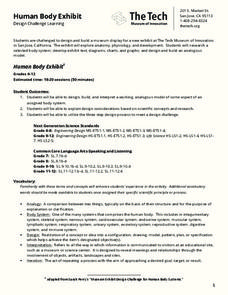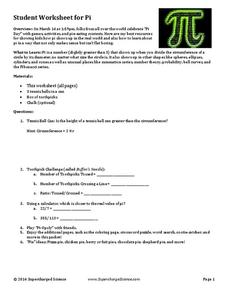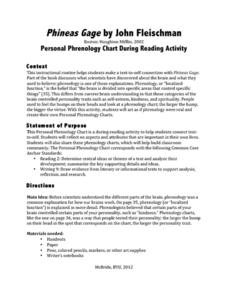Curated OER
The Grapes of Wrath: QAR--Question/Answer Relationship
Chapter nine of John Steinbeck's The Grapes of Wrath provides the text for an exercise that asks readers to think deeply about the items the Joads left behind and what these items might represent.
Sargent Art
Glass Jar Sand Art: Inspired by Navajo Sand Painting
Sand has been used as an artistic medium for centuries and can be found in cultures across the globe. The class examines sand art created by the Navajo people. They mix tempera paint and sand to create their colors, and then fill jars,...
Rational Number Project
Initial Fraction Ideas Lesson 18: Overview
Develop young mathematicians' ability to compare fractions with investigation into the number 1/2. After brainstorming a list of fractions equivalent to 1/2, children identify a pattern in the numerators and denominators that allows them...
Center for the Advancement of Ethics and Character
The Lion, the Witch, and the Wardrobe
C.S. Lewis' The Lion, the Witch and the Wardrobe is the anchor text for a three week unit that focuses on responsibilities, ethics, and virtues. While specific lesson plans are not included in this overview, a focus and discussion...
Curated OER
Hatchet: Concept Analysis
Take an in-depth look into Gary Paulsen's Hatchet with a concept guide. With a list and explanation of thematic motifs, types of conflicts, and vocabulary in the novel, learners will engage with the text in a whole new way.
Habits of Mind
Thinking Interdependently
Transform your class into a team with a lesson about thinking and working interdependently. As they reflect on important roles for a group, elementary and middle schoolers learn to work together and think of ways that compliment each other.
Bethel School District
Observations and Inference
What's the difference between qualitative and quantitative observations? Learners make observations, inferences, and predictions about their environment with a set of questions and activities that are applicable to either language arts...
Discovery Education
Make it all Better!
Discover how innovations can help your school and community. In the three-part STEM lesson, scholars learn the meaning of innovation and brainstorm innovations in their schools. They identify issues in their communities and think of...
Tech Museum of Innovation
Human Body Exhibit
Explore human anatomy and physiology using models. Scholars study systems of the human body and design a display for a museum exhibit. To complete the activity, individuals create analogous models of their chosen human body systems.
Curated OER
Worksheet for Pi
Who needs a pie-eating contest when you have a pi-ology game! Celebrate March 14th with a fun board game about pi and other geometric concepts. As learners answer questions about geometry, they move around the board to collect tokens.
Channel Islands Film
Arlington Springs Man: Lesson Plan 1
Learning to craft quality questions is a skill that can be taught. Class members use the Question Formulation Technique to learn how to create and refine both closed-ended and open-ended questions. They then view West of the West's...
Nosapo
Days of the Week
What do you usually do on Saturdays? What will you do on Thursday? Class members practice the simple future tense and the days of the week with a series of activities and questions. They then share their answers with a partner.
Curated OER
Learning From World War II and Connecting It to the Present
Compare and contrast World War II to the modern Iraq war with this instructional activity. After watching a film, learners use supporting evidence to support their point of view of the conflicts. Using the internet, they create a...
Pingry School
Synthesis of an Insoluble Ionic Salt: A Stoichiometry Experiment
Challenge young scientists to design their own experimental procedures. They write the procedure for properly preparing two grams of a water-insoluble ionic salt. To finish, they perform the experiment and collect data to prove their...
University of Colorado
Patterns and Fingerprints
Human fingerprint patterns are the result of layers of skin growing at different paces, thus causing the layers to pull on each other forming ridges. Here, groups of learners see how patterns and fingerprints assist scientists in a...
Curated OER
Paradise Lost: Problem Situation
Let your class voice their opinions with a group debate activity. Before reading John Milton's Paradise Lost, they work in small groups in assigned roles to form a position about authority and rebellion, comparing a teenager's punishment...
Curated OER
Phineas Gage: The Teenage Brain and Connections: Free Choice Activity
During this lesson, which is all about making connections, learners watch a documentary about the teenage brain and connect it to Phineas Gage: A Gruesome but True Story About Brain Science, their own lives, and the world.
Curated OER
Phineas Gage: Personal Phrenology Chart During Reading Activity
Phrenology, the belief that parts of your brain control certain aspects of your personality, is described in Phineas Gage: A Gruesome but True Story About Brain Science. While we now know much more about the brain, learners use this idea...
Novelinks
The Lion, the Witch, and the Wardrobe: Picture Book Strategy
Picture books aren't just for primary learners. Your scholars compare and contrast literary themes between the novel, The Lion, the Witch, and the Wardrobe by C.S. Lewis, and the children's book, The Dream Tree by Winfried Wolf through...
Novelinks
Zach’s Lie: The K-W-H-L Strategy
The attached resource is no lie! The K-W-H-L activity, which is fourth in a series of seven, serves as a pre- and post-assessment. First, pupils brainstorm what they know about a specific topic, then they list what they want to know, how...
Curated OER
The Trash We Pass
Where does our garbage go? What is the difference between a recyclable and non-recyclable item? Pose these important, but often overlooked, questions to your class and invite them to consider the lasting and damaging effects of the...
North Syracuse Central School District
Nutrition Label Worksheet
Nutritional labels are everywhere, yet so few of us take the time to use them! Here is a learning exercise that learners can use to practice calculating such features as calories, carbohydrates, and serving size based on real examples of...
Mr. Hill's Science Website
Solar System Fact Sheet
Here is a fantastic, educational handout packed with information and facts not only about the planets in our solar system, but also regarding major moons and their surface features, dwarf planets, comets, and asteroids.
Practical Pages
Famous Artist of the Month
Feature one famous artist a month with a series of portraits, biographies, and examples of their gallery. With masters such as Augustus Rodin, Francisco Goya, and Michelangelo, the resource provides opportunities every month for kids to...

























